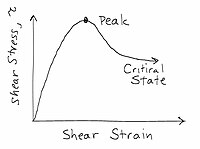
Photo from wikipedia
Abstract The consolidation state imposes great influences on the clay responses to subsequent cyclic loadings. So far most laboratory cyclic tests on clays focused on the isotropically or K0 consolidated… Click to show full abstract
Abstract The consolidation state imposes great influences on the clay responses to subsequent cyclic loadings. So far most laboratory cyclic tests on clays focused on the isotropically or K0 consolidated conditions, while few considered the anisotropically overconsolidated clays under various ratios of radial to vertical consolidation stresses. In this paper, a series of triaxial shear and long-term cyclic tests are performed on a remolded saturated clay in a triaxial apparatus, where the effects of cyclic stress ratio (CSR), ratio of radial to vertical consolidation stresses (K) and overconsolidation ratio (OCR) on the deformation behavior are investigated. The results of triaxial shear tests show that the decrease of K leads to the growth of peak deviatoric stress and the reduction of excess pore water pressure. The cyclic tests indicate that the increase of OCR restricts the development of axial strain greatly, while the consolidation-induced anisotropy appears to have little effects on the deformation. The shake-down on the deformation of anisotropically overconsolidated clays is analyzed and it is found that the cyclic stress boundary ratio, i.e., the allowable cyclic stress ratio, is 0.430 regardless of K. In addition, the accumulation of permanent axial strain is predicted by an empirical model and the quantitative relationships between the fitting parameters and CSR are determined. The relationships of fitting parameter B versus CSR are divided into two different regions by the allowable cyclic stress ratio, indicating that the prediction model of deformation should consider the shake-down ranges.
Journal Title: Soil Dynamics and Earthquake Engineering
Year Published: 2020
Link to full text (if available)
Share on Social Media: Sign Up to like & get
recommendations!